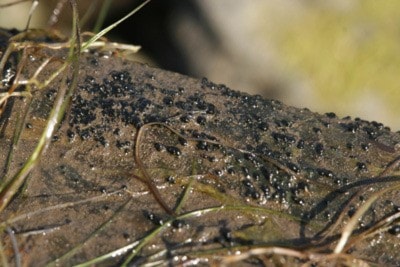Left, left, left, left ...
They may be small, but there’s a foreign army, helmeted and ready, marching upriver in Port Alberni — and one local environmentalist fears that nothing can stop them.
The force moving slowly up the Somass River estuary, comes from New Zealand and already numbers hundreds of thousands strong.
Rick Avis is a member of the Alberni Valley Enhancement Association, a non-profit group dedicated to the protection and restoration of watersheds in the Alberni Valley. He said he and his team are increasingly concerned about a slowly-moving wave of New Zealand mud snails (Potamopyrgus antipodarum), which appeared at the estuary and have been reproducing madly ever since.
“They were identified about three years by a visiting scientist who had experience with them in the Snake River system,” Avis said. “They are already in the Snake River system and the Columbia River up to Yellowstone Park. They are quite concerned about it and they have a working group trying to control it.”
In their normal habitat, the snails are preyed upon by a parasite, which sterilizes many of them, keeping the population in check. This regulatory mechanism is not present in foreign waters though, leaving them free to reproduce at will.
And, Avis said, what a will they have.
The snail, he said, is tiny, about two millimetres in length. However, what it lacks in size it more than makes up for in fertility. Left unchecked, they can number as many as half a million per square metre.
“They are parthogenetic, which means a snail doesn’t need to interact with a second snail in order to reproduce,” he said. “Once you get one, it can reproduce by itself and then its offspring can reproduce and once you get that they can reproduce wildly and blanket every surface.”
The Port Alberni infestation, he said, was the first of its kind in Canada, but if it plays out the same way it has in the United States, it likely won’t be the last.
That’s a concern, Avis said, because the snails have no natural predators here, so their huge numbers mean they eat the food normally consumed by native species.
“It takes over a large chunk of the resources available in the water column,” Avis said. “You end up with hundreds of thousands of snails and not much else. There’s a lot of concern about how this will impact the fisheries resource.”
The Somass River, he noted, is home to as many as 600,000 to 800,000 sockeye salmon that return there to spawn every year.
Avis said it’s unclear how the invasion began, although he said it’s likely they were transported on somebody’s fishing gear or in the bilge of a boat.
“It could have been a commercial freighter or a pleasure craft,” he said. “They are such tiny little things. They could even have come on somebody’s hip waders.”
The snails, he said, can survive in both fresh and brackish water, so while they can easily migrate upstream — albeit slowly — they won’t be fouling beaches on the coast.
That said, he stressed there is a possibility they could spread by other means, much as the so-called rock snot (Didymosphenia geminata), which spread on fishing gear from a river near Nanaimo to, among other places, Iceland and New Zealand.
“My concern is they might go to eastern Vancouver Island as well,” he said.
Because they need to live in fresh or at most brackish water, they are not going to spread out on the beaches like the Japense varnish clam (Nuttallia obscurata) or the ubiquitous Japanese mudflat snail. However, he said they could spread to east coast estuaries.
“You won’t see them on Parksville Beach or Qualicum Beach, but you may find them in the Little Qualicum or Englishman rivers,” Avis said. “What happens is they get onto people’s waders and unless people are disinfecting their waders, they have the potential to move it.”
Even if people fishing in infected areas follow this protocol, he added, the snails can still be spread by wild birds such as mergansers.
“It’s a difficult problem,” he said. “Here you have a tiny organism that can stand days of dehydration and can reproduce by itself.”
What Avis and his team would like to see, he said, is an education campaign warning people to take care not to transport the creatures.
“I would like to see better signage and more awareness,” he said. “Education is the key. You need to say to people that if you transport these things around, you are going to have to live with it.”
news@pqbnews.com
